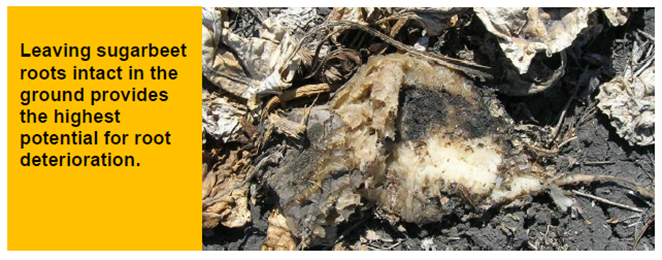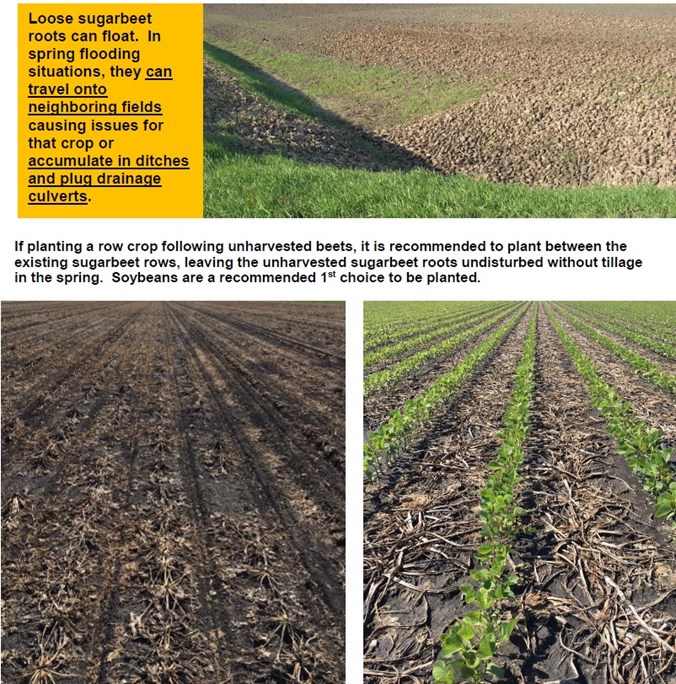633 - Managing Unharvested Beets
General Production Considerations on Unharvested Sugarbeet Acres
When sugarbeets are left unharvested there are management considerations that should be taken for crop production on those fields for the following year.
- Make a map of the unharvested areas for future reference.
- Unharvested areas in a field may justify separate management practices in future years than the rest of the field.
- Defoliate the sugarbeets.
- A flail shredder could be used as well.
- Defoliating/shredding will accelerate the release of nitrogen for the subsequent crop.
- It is recommended not to till unharvested sugarbeets.
- Deterioration of the sugarbeet root is enhanced when it is left in the ground surrounded by soil.
- Not being surrounded by soil creates a dry sugarbeet carcass and greatly increases the time to decay.
- Tillage will lift the sugarbeet root out of the ground and deposit the root nearly entirely whole on the soil surface.
- Multiple tillage passes would be required to incorporate, increasing fuel and labor costs.
- Dried, non-decaying sugarbeet root carcasses on the soil surface become a nuisance for the next crop in rotation.


- If spring tillage is required, consider ways to maximize stand establishment.
- If seedbeds are poor consider increasing seeding rates by 10% to overcome potential stand establishment problems with small grains, corn, or soybean.
Fertility Management on Unharvested Acres
Nitrogen
- Defoliation/Flail shredding of tops will accelerate release of nitrogen for subsequent crops.
- N in the sugarbeet tops will be available very early in the spring.
- The sugarbeet root material will tie up (immobilize) nitrogen making nitrogen fertility management challenging.
- Fall soil testing will not give an accurate index of available nitrogen.
- Spring soil testing would offer a bit more insight than Fall.
- Soil sample areas where beets were not harvested separately from the rest of the field as available nutrient differences are likely to occur.
- Additional actual Nitrogen will be needed for all non-legume crops.
- Each ton of sugarbeet roots with yellow tops will tie up about 5-6 lbs. per acre of soil nitrogen.
- Each ton of sugarbeet roots with green tops will tie up about 2 lbs. per acre of nitrogen.
- Plant soybeans on unharvested sugarbeet acres to avoid N management concerns.
- Spring applied N on unharvested beet acres will be used more effectively than Fall applied N.
- Apply N fertilizer as close to planting as possible to reduce nitrogen immobilization as unharvested beets decompose.
- Banded N for row crops will be more effective than broadcast nitrogen.
- Side dress part of the nitrogen after crop emergence to maximize N use efficiency for long season crops like corn.
- N management to achieve malting barley quality will be more challenging on areas of fields where beets were left.
Phosphorus and Sulfur
- P deficiency might occur on fields testing low or very low for phosphorus.
- Use past P soil test data on unharvested acres to determine fertilization level.
- Consider applying additional P fertilizer for crops with high demand like soybeans.
- Banded applications of P in the spring will be most effective.
- Starter P is recommended where practical to use it.
- Sulfur deficiency is not very likely but might occur early in the spring and disappear as crops root into subsoil sulfur supplies.
Potassium
- Leaving sugarbeet roots and tops shouldn’t alter the content of available K in the soil.
- No additional K fertilizer should be required - follow normal soil test recommendations
Diseases
- If unharvested areas had root disease present, these areas are likely to have increased inoculum levels in that part of the field for future sugarbeet crops.
- Plant small grains to reduce disease inoculum buildup on unharvested acres.
- If beets unharvested are in a field with an Aphanomyces history:
- The next time beets are planted, plant a high tolerant Aphanomyces variety and use Tachigaren up to 45 grams.
- If beets unharvested are in a field with Rhizoctonia present:
- Consider small grains instead of beans, corn or potato that build up Rhizoctonia inoculum.
- The next time beets are planted, plant a variety with high Rhizoctonia tolerance and use Azteroid fungicide in-furrow as well as a Post Rhizoctonia fungicide application.
Crops to Consider on Unharvested Sugarbeet Acres
- Soybean – 1st choice
- Soybeans are a legume and will use nitrogen available or make its own supply making them the best choice for Nitrogen management and lowering nitrogen input costs. Consider increasing plant populations by 10% if seedbeds are poor.
- Edible beans
- Edible beans are a legume and will use nitrogen available or make its own supply making them another good choice for Nitrogen management and lowering nitrogen input costs. Consider increasing plant populations by 10% if seedbeds are poor.
- Small grains
- Small grains will need an extra 30 - 40 lbs. of actual nitrogen added per acre to offset soil nitrogen tied up in soil by the extra sugarbeet organic matter.
- Sunflowers
- Sunflowers are a deep-rooted crop that will be less affected by nitrogen immobilization since they are planted later. They may require and extra 30-40 lbs. of nitrogen per acre to maximize yield.
- Corn
- Corn following sugarbeets can experience “fallow syndrome” requiring higher amounts of Phosphorous starter fertilizer, 10 gal/a 10-34-0 is the high limit to be placed in-furrow. Corn will need an extra 30-50 lbs. of actual nitrogen. A population increase of 10% is recommended for poor seedbeds conditions.
